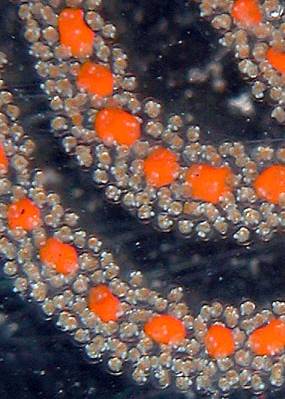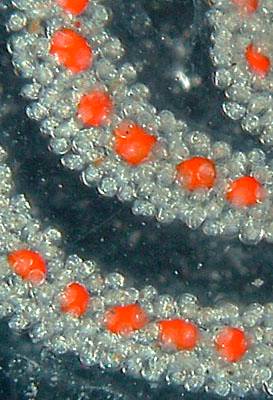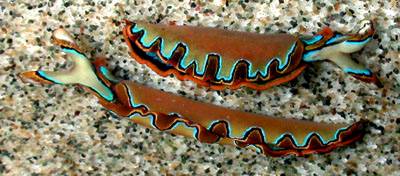
Thuridilla neona
Gosliner, 1995
Order: SACOGLOSSA
Superfamily: ELYSIOIDEA
Family: Elysiidae
DISTRIBUTION
Hawaiian Islands and south western Pacific
PHOTO
Hekili Point, Maui, Hawaiian Ids. Depth: 1-2 meters. 1 December 2002. Lengths: 10, 12 mm. Photos: Cory Pittman.
The body was described by Gosliner as 'green with a slight bluish tinge' but in Cory Pittman's photo the parapodia are a orange brown colour lightening to a greenish blue colour towards the parapodial edge, which is lined with three thin wavy submarginal bands - the innermost is bright blue, then black, and nearest the edge a bright yellow orange line. Outside these three lines is a broad dark orange band, as in T. undula, which varies in width along the mantle edge. On the inside of the parapodia the edge is orange, then there is a broad black band and then a region of reflective bright blue. The head and rhinophores are creamy white with a triple border of blue, black and orange, as on the parapodia. The foot is similarly coloured. It is a common, diurnal species in shallow Maui, according to Cory Pittman. See description of egg ribbon below.
Similarly coloured specimens are reported here from the Great Barrier Reef. There is also an apparent variant [see Thuridilla sp. 4] which most probably represents a green colour form [message #15079 ].
References:
• Gosliner, T.M. (1995) The genus Thuridilla (Opisthobranchia: Elysiidae) from the tropical Indo-Pacific, with a revision of the phylogeny and systematics of the Elysiidae. Proceedings of the Californian Academy of Sciences 49(1): 1-54.
Rudman, W.B., 2005 (October 31) Thuridilla neona Gosliner, 1995. [In] Sea Slug Forum. Australian Museum, Sydney. Available from http://www.seaslugforum.net/find/thurneon
Related messages
Thuridilla neona from sthn Queensland
February 6, 2009
From: Gary Cobb
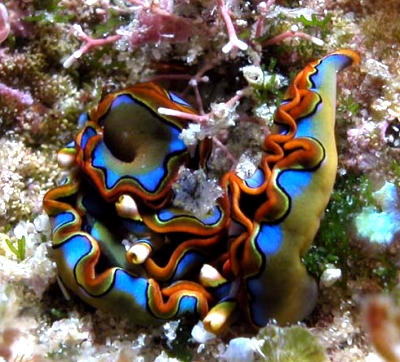
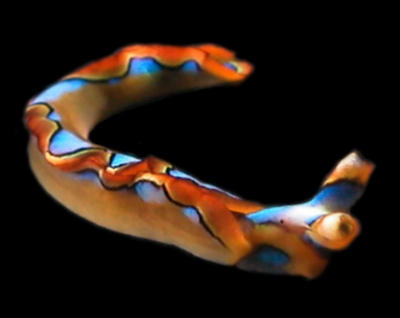
Concerning message #15140:
Hi Bill and everyone!
It looks like it has been a drought as far as Thuridilla neona goes! After 3 recent visits to Flinders Reef north of Moreton Island we have found quite a few of these beautiful animals crawling on the tops of the small bommies.
I have included a photo of David actually shooting an animal in the wild with our black slate.
Locality: Flinders Reef, Moreton Island, 13 m, Queensland, Australia, Pacific Ocean, 26 December 2008, Subtidal. Length: 8-15 mm. Photographer: Gary Cobb and David Mullins.
So here is a record from sthn Queensland.
Cheers Gary
gary@nudibranch.com.au
Cobb, G.C., 2009 (Feb 6) Thuridilla neona from sthn Queensland. [Message in] Sea Slug Forum. Australian Museum, Sydney. Available from http://www.seaslugforum.net/find/22169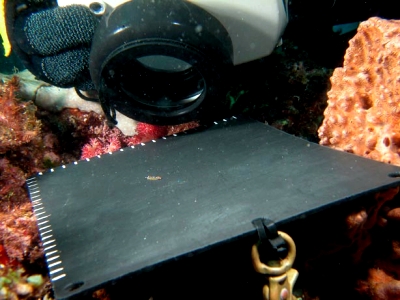
Thanks Gary,
Best wishes,
Bill Rudman
Re: Elysia colors
November 2, 2005
From: Skip Pierce
Hi Bill,
I know mostly no answers to your questions [message #15134]. Could be a couple of MS theses here. However, anecdotally, many, maybe all, of the color 'granules' are actually clusters of cells. In Elysia, the food-related color changes are typically green or not, of course and are associated with the digestive tubules. I've no idea of the source of the orange, red and blue pigments (ie synthetic or food), but they are in movable cells (and actually there is more than one kind of cell, at least morphologically) and they seem to be outside the digestive system in the hemocoel and so can move anywhere the blood goes, and they do move around in the same specimen over time. As far as I am aware, there is nothing known about hemopoiesis or degradation. I've no idea what controls where they are when (although I'm wondering if the orange at the parapodial tips isn't a sunscreen, maybe). Finally, I do think that a large blue patch could be concentrated into a thin blue line, perhaps. Also an orange band made up of individual cells could disappear by simply spreading the cells out or moving them into the interstices of the hemocoel and reappear vice versa...but it's all unknown as you point out.
Skip
pierce@cas.usf.edu
S. K. Pierce, 2005 (Nov 2) Re: Elysia colors. [Message in] Sea Slug Forum. Australian Museum, Sydney. Available from http://www.seaslugforum.net/find/15154Thuridilla neona and colour patterns
October 31, 2005
From: Skip Pierce
Hi Bill,
My usual disclaimers up front here and I have never seen a Thuridilla on the hoof, but I think this recent discussion [#15121] illustrates some of my points, again AMONGST THE ELYSIIDS ONLY [message #15109]. I continue to have no expertise about the other taxa. I can't tell from your blow up of the recent T. neona photos whether we are looking at pixels or we can actually see the pigment containing cells I referred to in my previous message (although we have all been seduced by digital photography - and the Forum would be impossible without it - digital resolution compared to film is awful and will be so until the size of a pixel approaches the size of a silver atom -but that's another story), but if the orange and blue pigments in Thuridilla are in round, unattached hemocytes as they are in Elysia (and as it looks like they might be in the blow up), it is an example of my thought that taxonomic discussions about positions, widths, shapes, etc of color bands (By the way I don't know about the black lines, the species we work on do not have such) made up of these kind of cells can be misleading. Those cells can and do move around in the hemocoel within the same specimen, so the banding pattern changes. If, on the other hand, the pigments are located in an epithelial (or at least in a non-moveable) cell type, then genetics is in play and the patterns of bands and spots are of taxonomic merit.
Skip Pierce
pierce@cas.usf.edu
Pierce, S.K., 2005 (Oct 31) Thuridilla neona and colour patterns. [Message in] Sea Slug Forum. Australian Museum, Sydney. Available from http://www.seaslugforum.net/find/15134Dear Skip,
Since most of these species have been described from few specimens, it certainly illustrates the need to know more about them before either naming them or trying to identify them. I may be speaking too soon, but some species, such as T. moebii and T. decorata, seem quite constant in colour pattern, but many of the others, with blues and yellow-orange-red colours seem to have problems. When you talk about observing colour 'granules' changing position does this also include a non-food related colour disappearing? I am thinking there is a big difference in surface area covered between a thin blue line and a series of large blue patches, or between a large undulating orange band of variable thickness and a thin orange line. Where would the extra pigment granules go?
Looking through earlier comments I have made when identifying photos of Thuridilla on the Forum, my recurring theme has been 'I am not sure'. We either have a lot more species to define, or else we need to seriously consider 'lumping' some of the existing ones. But as your comments suggest - we need to know a lot more about them first. Thanks for your non-taxonomist perspective.
Best wishes,
Bill Rudman
Thuridilla neona from Lizard Island
October 31, 2005
From: Ingo Burghardt
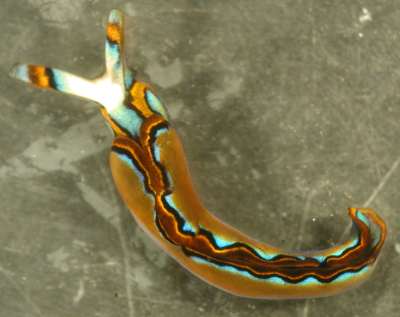
Dear Bill,
To join the conversation on Thuridilla [#15121], here are some fotos of one specimen of Thuridilla neona, that I found last year close to Lizard Island. The colour pattern appears quite "classical" for this species. Like Thuridilla livida from the same locality it showed no photosynthetic activity, so probably it does not retain any chloroplasts.
Locality: Bird Island, Lizard Island Group. Great Barrier Reef, Australia. Depth: 1-2 m.. Length: 9 mm. August 2004. Intertidal between coral rubble. Photographer: Ingo Burghardt
Cheers,
Ingo
ingo.burghardt@rub.de
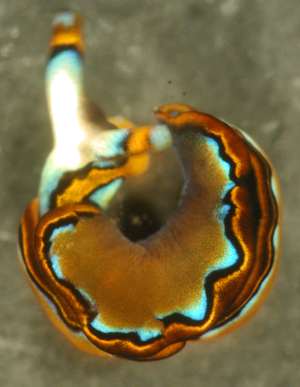
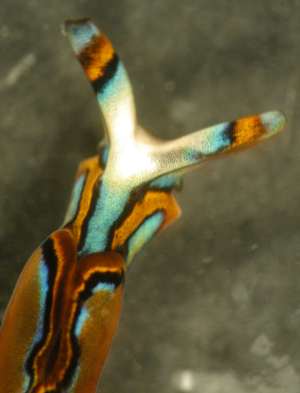
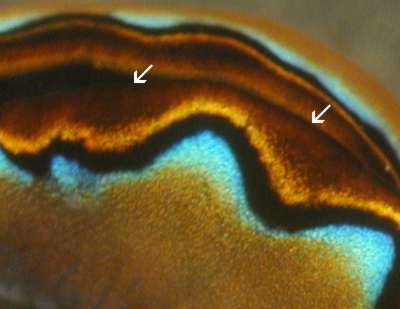
Dear Ingo,
Thanks for these photos which certainly resolved one aspect of the colour pattern for me. I had thought from Cory Pittman's photos [#9719] that in T. neona, the thin bright yellow line was at the edge of the parapodia, and the undulations Terry Gosliner described were referring to the 'wavy' edge of the parapodia. However from your photos - see arrows alongside - there is an orange - or dark brown-orange border which varies in width. This is also the case in Julie Marshall's photos [#15121 ].
Looking back at Cory's photos, I can see that if I interpret the the dark patches along the parapodial edge as the wider parts of a brown-orange border, we have the same pattern as the Great Barrier Reef animals. I had previously interpreted these dark patches as the space inside the parapodia. Now I see the error of my ways it all seesm so clear!
Which brings us to Daniel Foote's animal [#15079]. My feeling now is that it is a well-fed Thuridilla neona. Your observation that this species doen't seem to retain chloroplasts would fit. His animal with green parapodia can be interpreted as a recently fed animal, while the others with orange-brown parapodia would represent 'starving' animals without chloroplasts in their digestive gland ducts. At this stage, I think it is best to interpret the different colour pattern on the head in Daniel's animal, to be part of the species colour variation. Certainly the photos we now have suggest the blue colour along the parapodial edge can range from a line to a series of blue patches.
So after a few days of confusion - mainly on my part - we can pretty safely say that T. neona is no longer just an Hawaiian endemic.
Best wishes,
Bill Rudman
Re: Thuridilla cf. neona? from Great Barrier Reef
October 28, 2005
From: Julie Marshall
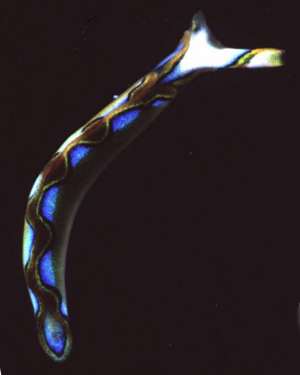
Dear Bill,
In response to your comments to Daniel Foote's message [#15079] here is a photo of Thuridilla neona from Heron Island [Great Barrier Reef] which extends its range from Hawaii. Although unfortunately missing one rhinophore the remaining one clearly shows the distinctive orange diagonal band across it with a black line on each side and a blue band on the lower side.
Locality: Heron Island, Great Barrier Reef, Queensland, Australia. Depth: 13 m. Length: 7 mm. 8 December 1999. Coral substrate. Photographer: Julie Marshall
Best wishes
Julie Marshall
juliemarshall@netspace.net.au
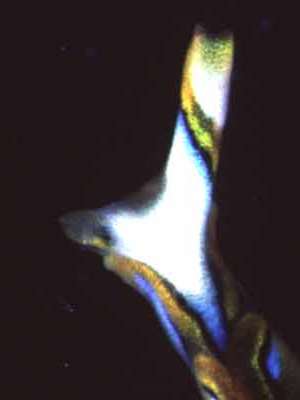
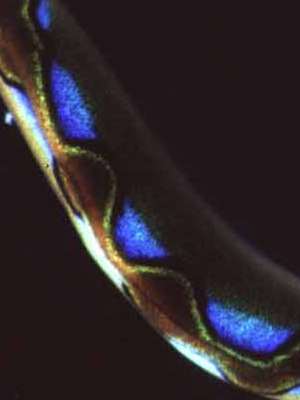
Note added 31 Oct 2005: This is most probably a colour variant of T. neona. See message #15140.
Dear Julie,
Thanks for the interesting photo. It reinforces my feelings that we haven't got this group of species sorted out properly at present. I agree with Skip Pierce's comments [#15109] that we need to use colour with care, but every new photo of this T. neona - T. indopacifica colour group throws up inconsistencies. And we need to consider Thuridilla sp. 3 and Thuridilla sp. 4. as well.
Your animal certainly has the diagonal yellow, black and bluish bands on the rhinophores as in T. neona, but the color bands on the parapodial border are quite different. In T. neona the orange-yellow, black and blue marginal bands are thin lines whose width does not vary along their length. Both the photos on the Forum, and Gosliner's description show this. In your animal the orange marginal line varies in width along its length, there are then thin yellow and blue lines which don't vary in width, and then a series of large blue patches. To add to the confusion, your animal and Daniel Foote's although the same in most colour features, differ in the color of the head. These animals, which I am calling ' Thuridilla sp. 4' also differ from both T. neona and T. indopacifica in the way the orange mantle border varies in width as in T. undula. Thuridillasp. 4. therefore has the general colour of T. indopacifica, the rhinophore bands of T. neona, and the wavy, 'undulate' orange border of T. undula.
If anyone else has photos to throw into the melting pot and hopefully throw light on this puzzle, they would be very welcome.
Best wishes,
Bill Rudman
Thuridilla cf. neona? from Great Barrier Reef
October 26, 2005
From: Daniel Foote
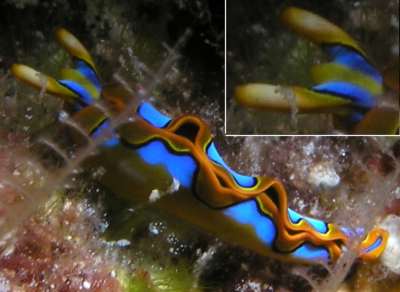
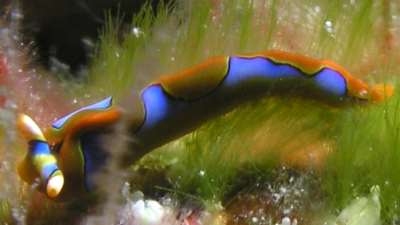
Dear Bill,
Thanks very much for the promptness of your replies [message #14910], it is much appreciated. I have been out at sea for the last 2 weeks so haven't been able to reply before now. Here are the photos that you requested. I hope they can help you. It is the same animal as before.
Yours Sincerely
Daniel Foote
pelagicdan@yahoo.co.uk
Foote, D.J., 2005 (Oct 26) Thuridilla cf. neona? from Great Barrier Reef. [Message in] Sea Slug Forum. Australian Museum, Sydney. Available from http://www.seaslugforum.net/find/15079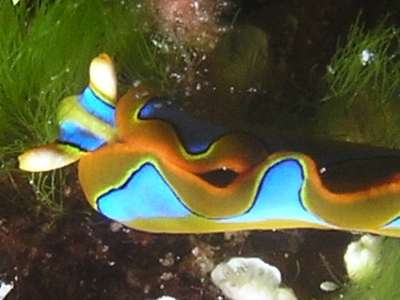
Note added 31 Oct 2005: This is most probably a colour variant of T. neona. See message #15140.
Thanks Daniel,
It's just what I needed, a good photo of the head. I am not sure that it solves the indentity of your animal but it may have given us some clues. As far as I can see, no other species has a blue head with a yellow median stripe like yours. However Thuridilla neona, which was your original suggestion, has an orange diagonal band across each rhinophore with a black line on each side and a blue band on the lower side - which could be equivalent to the yellow band, bordered with black at the base of each rhinophore. The blue patches on the parapodia are rather different and there is no hint of green in T. neona but that could be a variation. At this stage T. neona is known only from the Hawaiian region. There is also the possibility that it is a new species, so I think I will move it to a separate pages as Thuridilla sp. 4.
Best wishes,
Bill Rudman
Thuridilla neona? off Townsville, QLD
October 8, 2005
From: Daniel J. Foote
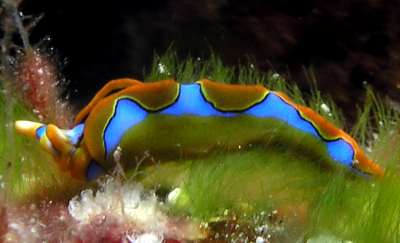
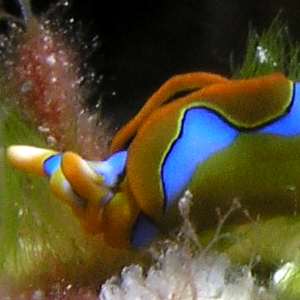
This photo was taken at Flinders Reef off Townsville in about 20 metres of water on a 1000 metre wall.
Locality: Flinders reef, off Townsville, Coral Sea, Qld, Australia. Depth: 20 m. Length: 1 cm. 15th August 2005. On wall. Photographer: Daniel J. Foote
From what I have found I believe it may be a Thuridilla neona. Thought you might be interested.
Daniel Foote
pelagic_dan@yahoo.co.uk
Foote, D.J., 2005 (Oct 8) Thuridilla neona? off Townsville, QLD. [Message in] Sea Slug Forum. Australian Museum, Sydney. Available from http://www.seaslugforum.net/find/14910Note added 31 Oct 2005: This is most probably a colour variant of T. neona. See message #15140.
Dear Daniel,
This is an interesting find. Despite Terry Gosliner's exhaustive review of the genus Thuridilla we still have some work to do. Your animal has similarities to T. undula, T. neona and T. indopacifica.
In the original description of T. undula it is hard to see from the photo, or from the description, whether the orange parapodial border has a uniform width or not. The Fact Sheet photo from the Solomon Ids suggests it doesn't. It seems to have whitish parapodia with an orange border, a black submarginal line, and diffuse blue patches. Your animal is possibly a variation of this species, but the bright green colouration in your animal, which I suspect is from the digestive gland, may be masked by opaque whitish pigmentation in the Solomons animal. However, the thin yellow line, alongside the black line, has not previously been reported from T. undula.
In T. neona - there are thin orange, then black, then blue lines, of equal width, running parallel to the edge of the parapodia. The parapodia are described as 'greenish' by Gosliner, or orange brown in Forum photo.
T. indopacifica does have greenish parapodia, but the edge of the parapodia has thin black, orange and black lines and then a row of blue spots, running parallel to the edge of the parapodia. There are whitish spots all over the parapodia as well.
I suspect your animal may be a colour variation of T. undula. If you have a dorsal photo of the head, it might show us the colour pattern of that region. Markings on the rhinophores and head may turn out to be important in identification.
Best wishes,
Bill Rudman
Egg masses of Thuridilla neona (1)
April 23, 2003
From: Cory Pittman

Dear Bill,
Following on the discussion concerning the egg ribbon of Elysia maoria here is soem information on Thuridilla neona. It is a common, diurnal species in shallow Maui waters and is another example of an elysiid that produces prominent granules of “extra-capsular yolk”. In this case, the granules appear to be centrally (or ventrally?)located along the axis of the ribbon as indicated by the presence of eggs on top of some of them in the close-ups.
The animals in the first photo were collected on Dec. 1, 2002 at Hekili Point, Maui at a depth of one or two meters. Their lengths were 10 mm and 12 mm. I held them in a dish for several days and both laid eggs. The two photos in this message show the masses a few hours after laying. The loosely coiled mass measured 6.4 mm by 5.5 mm. The tightly coiled mass was 2.9 mm in diameter. The ribbons in both were about 0.4 mm thick and nearly cylindrical in cross section.
In a separate message there are three close-ups of a portion of the loosely coiled ribbon taken, respectively, a few hours after laying, about two days later and about five days later. The eggs gradually lost their orange pigment as they developed while the granules remained largely unchanged. Hatching occurred after about six days. The larvae, on hatching, were transparent and the granules remained visible in the ribbon after they hatched.
I hope this will be of interest.
Best wishes,
Cory
norm@maui.net
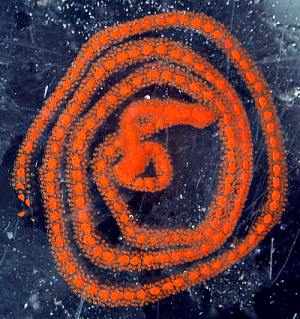
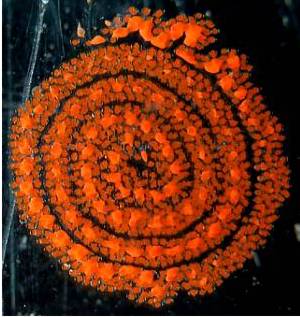
Thanks very much Cory,
These are fascinating observations. It looks as though the photos of the egg ribbon of Elysia vatae on the Forum are very similar to what we see here in T. neona. From your close-ups in the separate message, it certainly appears that the embryos surround the yolk 'blobs' and so have access to them, which seems to be quite different from the case of Elysia maoria. However from your observations and close-ups it doesn't seem the embryos [developing larvae] utilise the 'yolk' at all. Which makes me wonder what its there for at all. All the 'yolk blobs' in E. maoria are postitioned differently, there is a great similarity. If they are not food reserves for the developing larvae, perhaps they are decoys? If I am allowed the luxury of wild speculation, perhaps they are full of antifeedant chemicals and are decoy eggs to attract and discourage potential predators.
Best wishes,
Bill Rudman
Egg masses of Thuridilla neona (2)
April 23, 2003
From: Cory Pittman
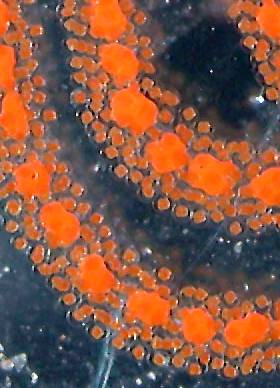
Dear Bill,
To accompany my other message concerning the egg ribbon of Thuridilla neona, here are some closeups showing developmental changes in the egg ribbon. To accompany the close-ups much of the first message is repeated here. Thuridilla neona is another example of an elysiid that produces prominent granules of “extra-capsular yolk”. In this case, the granules appear to be centrally (or ventrally?) located along the axis of the ribbon as indicated by the presence of eggs on top of some of them in the close-ups. These three close-ups of a portion of the loosely coiled ribbon taken, respectively,
upper right: a few hours after laying,
lower left: about two days later and
lower right: about five days later. The eggs gradually lost their orange pigment as they developed while the granules remained largely unchanged. Hatching occurred after about six days. The larvae, on hatching, were transparent and the granules remained visible in the ribbon after they hatched.
I hope this will be of interest.
Best wishes,
Cory
norm@maui.net
